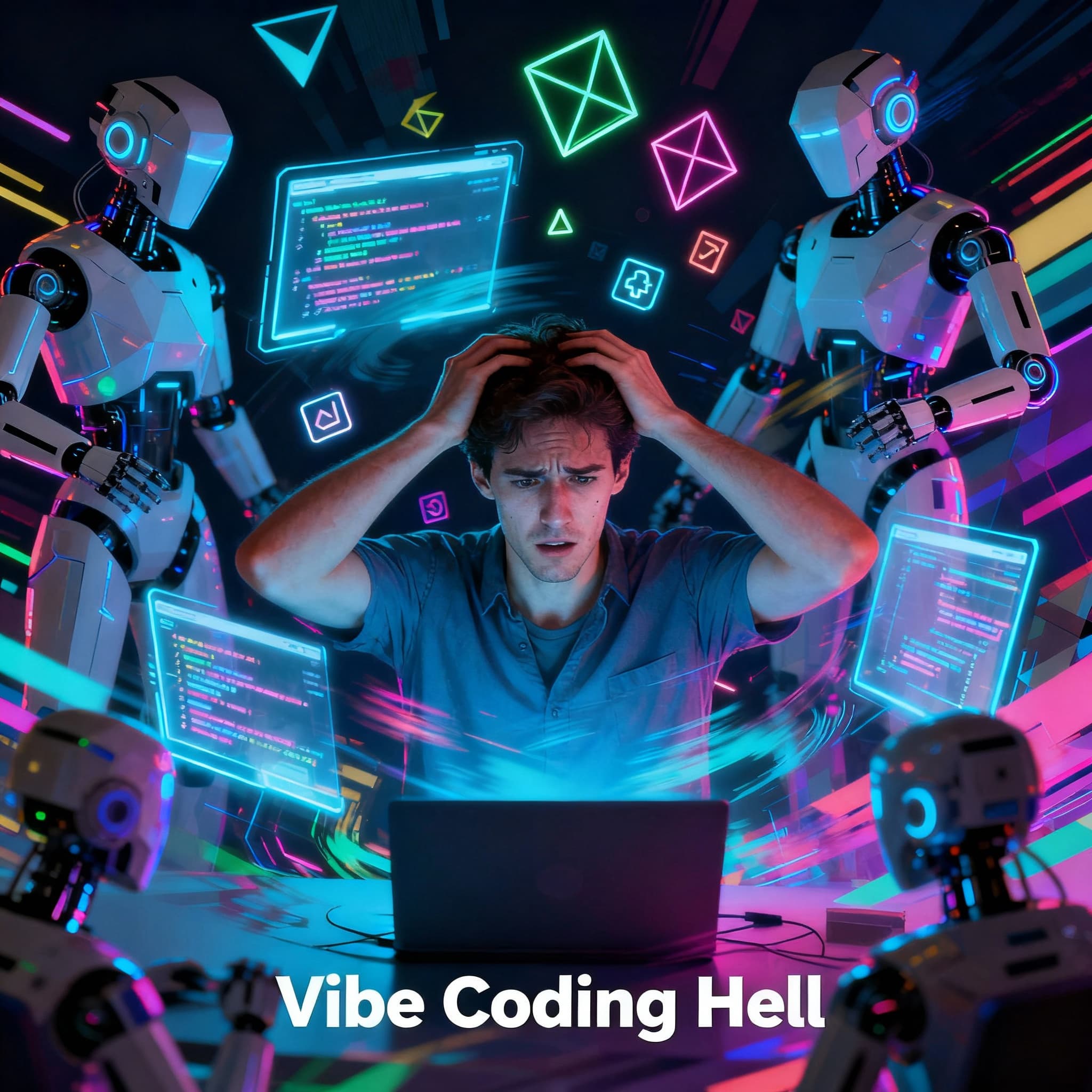Need help with your web app, automations, or AI projects?
Book a free 15-minute consultation with Rajesh Dhiman.
Book Your Free 15-Min Strategy Call
The Architect and the Intern: A Powerful Mental Model to Master AI-Powered Development
The Love-Hate Relationship with AI Coding Assistants
Let's be honest. Using an AI coding assistant like GitHub Copilot can feel like a rollercoaster. One minute, it’s a genius, writing a perfect function that saves us an hour of work. The next, it’s gone completely off the rails, inventing libraries that don't exist and leaving us to clean up the mess. Sound familiar?
We were promised a productivity revolution, but instead, we're stuck in a weird cycle of debugging code we didn't even write. It’s like the AI is a brilliant but chaotic new intern who occasionally tries to burn down the kitchen.
The problem isn't the AI; it's how we're using it. Many of us have fallen into "vibe coding", we give the AI a vague idea, cross our fingers, and hope for the best. This is where the frustration starts. To fix it, we need a new mental model: The Architect and the Intern.
Why Our Current AI Workflow Feels Broken
If we've ever wanted to throw our computer out the window after an AI "hallucination," we're not alone. The "vibe coding" approach usually fails for a few key reasons.
- Context Collapse: Imagine trying to help someone build a house, but you can only see one brick at a time. We'd have no idea where the walls go or if we're even building the right thing. That's our AI. Its context window (its short-term memory) is tiny, so it quickly forgets the overall project plan and starts generating code that just doesn't fit.
- Creative Hallucinations: When an AI gets lost, it doesn't stop and ask for directions. It guesses. And oh boy, does it get creative! It might invent a function that sounds plausible but doesn't exist, or use an outdated, insecure practice. It’s not malicious; it's just trying its best to fill in the blanks, often with disastrous results.
- The Debugging Loop from Hell: This leads to an exhausting cycle: we ask the AI to do something, it hallucinates a solution, we correct it, and it hallucinates something else. We spend more time reverse-engineering the AI's weird logic than we would have spent just writing the code ourselves. Our flow state is shattered, and our productivity plummets.
The big mistake here is trusting the AI with the blueprints. It’s a great helper, but it’s a terrible architect.
A Better Way: The Architect and the Intern Model
So, how do we fix this? We give everyone a clear job title. In this new workflow, we’re the Architects, and the AI is our eager-to-please Intern.
- We, The Architects: Our job is the big-picture thinking. We're in charge of the "why" and the "what." We design the entire system, break down complex problems into small, logical pieces, and define exactly what needs to be done. We’re the creative directors, the strategists, and the ones who ensure the final product is solid and secure.
- The AI, The Intern: The AI’s job is the "how." It’s a force multiplier for the grunt work. Give it a small, well-defined, and isolated task, and it will knock it out of the park. It’s perfect for writing boilerplate code, creating unit tests for a function we’ve already designed, or handling other repetitive tasks that drain our energy.
This division of labor lets us focus our brainpower on what truly matters—innovation and smart design—while our AI intern handles the busywork.
A Practical 4-Step Guide to Putting This into Action
Ready to give it a try? Transitioning to this model just takes a little discipline.
Step 1: Think Like a Project Manager
Before you write a single prompt, you have to break down the feature into tiny, unambiguous "micro-tasks." Don't just ask the AI to "build a user profile page." That's a recipe for disaster.
Instead, create a to-do list for your intern:
- "Create a database migration that adds a
bio(TEXT) andprofile_picture_url(VARCHAR) column to ouruserstable." - "Write a React component named
ProfileAvatar. It should accept one prop,imageUrl, and display an image in a 100x100px circle." - "Write an API endpoint at
/api/users/:id. It needs to fetch and return only the user'sname,bio, andprofile_picture_url."
See how clear and specific those are? The AI can’t really mess that up.
Step 2: Master the Art of the "AI Ticket"
Your prompts need to be so clear that there’s zero room for guessing. Think of each prompt as a perfectly written Jira ticket.
- Give It Context: Provide any relevant code snippets, file paths, or library names. "Here is the
Usermodel; you'll need it for this task." - Set Clear Acceptance Criteria: Tell it exactly what "done" looks like. "The function should return
trueif the email is valid andfalseotherwise." - Add Constraints: Be explicit about rules. "Use our standard linter settings. Do not use any external libraries for this task."
Step 3: Use Tests to Guide the AI
This one is a game-changer. Use a Test-Driven Development (TDD) approach. First, you (the Architect) write a failing test that perfectly defines what you need.
Then, you hand that test to your AI intern with a simple, beautiful command: "Write the code to make this test pass."
This gives the AI a concrete, verifiable goal. It’s no longer guessing; it’s solving a puzzle where the answer key (the test) is already written.
Step 4: Always, Always Do a Code Review
You wouldn't let a real intern push code to production without looking at it, right? Treat the AI the same way. Every line of code it generates must be reviewed by you.
Check for logical errors, security flaws, and whether it fits into the grand architecture. This final human check is what separates a professional, AI-powered workflow from a risky gamble.
From Coder to Architect: Our Role is Evolving
The Architect and the Intern model is our ticket out of the AI frustration loop. It’s a structured workflow that puts us back in control, improves our code quality, and makes development fun again.
This isn’t just about getting better at prompt engineering. It’s about elevating our role. As AI gets better at writing the code, our value shifts from typing to thinking. We become the true architects of technology—the visionaries who design the systems that AI helps us build.
So go ahead, give your new intern a clearly defined task. You might be surprised at how productive it can be.
If you found this article helpful, consider buying me a coffee to support more content like this.
Related Articles

Discover the best AI tools for developers in 2025, including ChatGPT Plus, Cursor.ai, GitHub Copilot, and more. Learn how these tools enhance coding efficiency through real-world insights and performance reviews.

AI coding tools are changing how developers work. Not by replacing them, but by helping them plan, test, and build software faster. Here’s the simple explanation.

Are you stuck in 'Vibe Coding Hell'? Learn why AI-assisted coding without understanding is dangerous, how it differs from tutorial hell, and discover practical strategies to build real programming skills while using AI tools like ChatGPT, GitHub Copilot, and Claude effectively.
Need help with your web app, automations, or AI projects?
Book a free 15-minute consultation with Rajesh Dhiman.
Book Your Free 15-Min Strategy Call